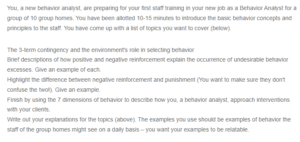Staff Training – Basic Behavior Concepts and Principles
The 3-Term Contingency and the Environment’s Role in Selecting Behavior
The three-term contingency is a term in operant conditioning that describes the link between behavior, consequence, and environmental context (Cooper et al., 2019). Behavior is usually stimulated by one’s environment, and the result of that behavior can influence its future occurrence. Both undesirable and desirable behaviors can be learned and sustained through interaction with the physical and social environment.
Negative and Positive Reinforcement
Negative and positive reinforcement could lead to undesirable behavior excesses. For instance, if every time an individual cleans their room they are given money to reinforce cleanliness, they can develop a great love for money to the extent that they might begin stealing. When one is given an antacid to avoid stomach upset before taking a favorite meal, they are likely to overeat.
Negative reinforcement differs from punishment in that the former strengthens or increases a behavior, whereas the latter weakens or lessens a behavior. The word negative in negative reinforcement implies the subtraction or removal of the stimulus following a behavior (Miltenberger, 2015). For example, individuals at the group home can be motivated to clean their rooms to avoid constant nagging. Nagging is the unpleasant thing that has been removed to enhance the probability of the desired behavior. In negative punishment, one’s favorite activity, like TV time, can be cut back or eliminated for some time to discourage them from talking back at others.
Approaching Interventions with Clients
I use the applied dimension to effect changes in behaviors that enhance clients’ lives. Using the behavioral dimension, I select the specific behavior that requires improvement. The analytic dimension requires me to control the non-occurrence and occurrence of a behavior. I use the technological dimension to identify and describe all operative procedures with clarity and detail to help a reader replicate the application with similar results. In addition, I use the conceptually systematic dimension to ensure that procedures for behavior alteration and other interpretations of why or how those procedures were effective are described regarding the relevant principles they were derived from. Effective dimension requires me to improve on the investigated behavior to a practical extent. Lastly, I use generality to ensure that clients’ behavior change lasts over time, can be displayed under different environments, and can be spread to other behaviors that the intervention does not treat directly (Cooper et al., 2019).
References
Cooper, J.O. Heron, T.E. Heward, W.L. (2019). Applied behavior analysis (3rd ed.). Pearson.
Miltenberger, R. G. (2015). Behavior Modification: Principles and Procedures (6th ed.). Cengage Limited.
ORDER A PLAGIARISM-FREE PAPER HERE
We’ll write everything from scratch
Question 
You, a new behavior analyst, are preparing for your first staff training in your new job as a Behavior Analyst for a group of 10 group homes. You have been allotted 10-15 minutes to introduce the basic behavior concepts and principles to the staff. You have come up with a list of topics you want to cover (below).

Staff Training – Basic Behavior Concepts and Principles
The 3-term contingency and the environment’s role in selecting behavior
Brief descriptions of how positive and negative reinforcement explain the occurrence of undesirable behavior excesses. Give an example of each.
Highlight the difference between negative reinforcement and punishment (You want to make sure they don’t confuse the two!). Give an example.
Finish by using the 7 dimensions of behavior to describe how you, a behavior analyst, approach interventions with your clients.
Write out your explanations for the topics (above). The examples you use should be examples of behavior the staff of the group homes might see on a daily basis – you want your examples to be relatable.